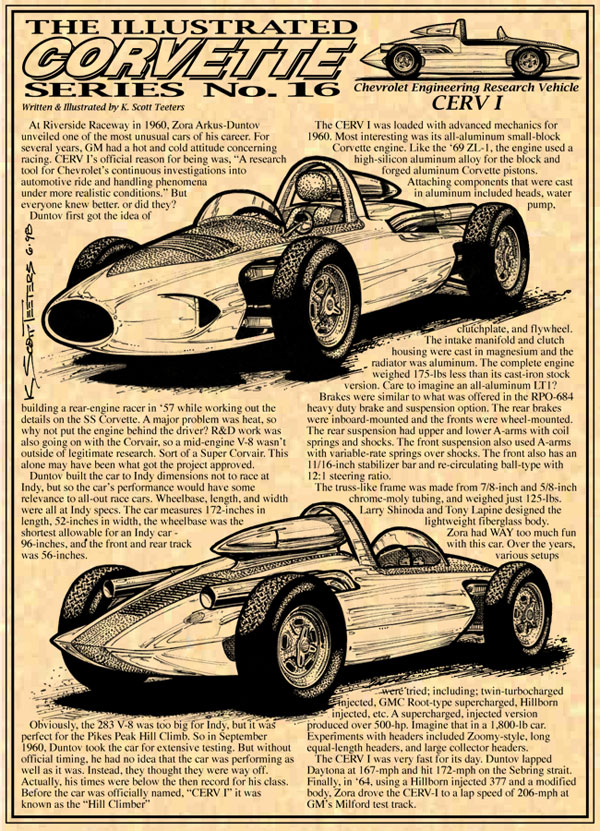The 57-Year Saga to the C8 Mid-Engine Corvette – The Old Mid-Engine Advantage & the 1960 CERV I
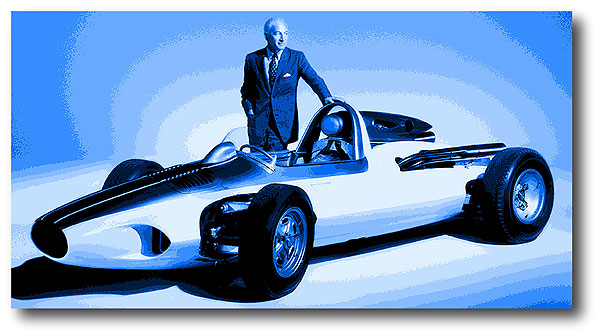 Dateline: 8.13.17 – Images: GM Archives & Mecum.com – Introduction: Honestly, I didn’t believe it at first. It seemed like the floodlights from the debut of the C7 Corvette weren’t even cool yet when the automotive press and the Internet started chattering about the C8 Corvette being a mid-engine design. GM then added fuel to the fire when it was announced that they had trademarked the word “Zora” which ignited the speculation of a mid-engine Corvettes.
Dateline: 8.13.17 – Images: GM Archives & Mecum.com – Introduction: Honestly, I didn’t believe it at first. It seemed like the floodlights from the debut of the C7 Corvette weren’t even cool yet when the automotive press and the Internet started chattering about the C8 Corvette being a mid-engine design. GM then added fuel to the fire when it was announced that they had trademarked the word “Zora” which ignited the speculation of a mid-engine Corvettes.
Part of Corvette-lore is that Zora Arkus-Duntov unsuccessfully tried many times to make the Corvette a mid-engine car, because in Zora’s day, it made perfect sense. The trouble was that Chevrolet was selling enough Corvettes to make the argument that, “the Corvette wasn’t broken, so don’t fit it!” The mid-engine Corvette concept lost its champion after Duntov retired in 1975. Dave McLellan’s team tried to recycle the body design of the mid-engine Four-Rotor Corvette, powered by a transverse-mounted small-block Chevy engine. That idea was actually “approved” briefly, but died a quick death. The mid-engine Corvette concept came back again as a development program that started with the Corvette Indy (a full-size static model), the Running Corvette Indy (a functional, drivable version), and finally the CERV III. This CERV III was an almost completely flushed out car, meaning that it “could” have been put into production, had GM not been embroiled in a financial crisis in the early ‘90s. The crisis was so bad that once again, the Corvette was on the chopping block!
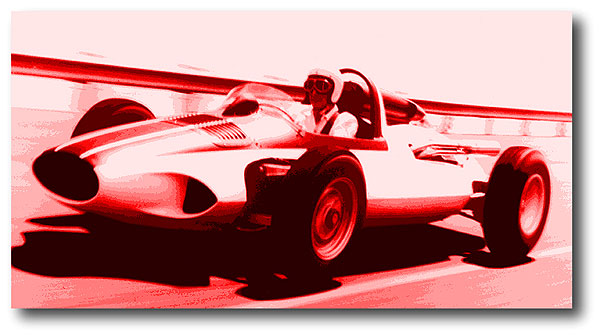 Perhaps by sheer luck, the C5 plan eked through and turned out so good, that the mid-engine concept then seemed antiquated. Then suddenly, shortly after the C7 came out, the Mighty Wurlitzer Rumor Organ got cranked up and once again, we are in mid-engine mania. But does the mid-engine make sense? Is this what the Corvette community really wants? I’ve had my head plugged into the world of Corvettes since 1965 and followed all of the mid-engine Corvette concept cars. Most were engineering studies and not real, drivable, serviceable, safe cars – a few were close to production-ready.
Perhaps by sheer luck, the C5 plan eked through and turned out so good, that the mid-engine concept then seemed antiquated. Then suddenly, shortly after the C7 came out, the Mighty Wurlitzer Rumor Organ got cranked up and once again, we are in mid-engine mania. But does the mid-engine make sense? Is this what the Corvette community really wants? I’ve had my head plugged into the world of Corvettes since 1965 and followed all of the mid-engine Corvette concept cars. Most were engineering studies and not real, drivable, serviceable, safe cars – a few were close to production-ready.
The “story” of the Corvette is long and rich with colorful characters, loud and awesome machines, and two, BIG, “Could’a been so cool!” chapters – The Grand Sport and the mid-engine Corvette. While it was wonderful that Chevrolet used the Grand Sport moniker for one of the two special-edition 1996 C4 swan song Corvettes, and then as a separate model Corvette starting in 2010, these were not Duntov’s original vision. The original five Grand Sports were more “silhouette” Corvettes with minimal production Corvette hardware, and the 1996 Grand Sport, the 2010-2013 C6 Grand Sport and now the C7 Grand Sport are separate model Corvettes, using most of the performance hardware of the quasi-racer Z06. But the mid-engine configuration is arguably the most radical of all Corvette designs and as we move forward towards the C8, this will be a total game-changer in many ways.
The Mid-Engine Concept: One of the first mid-engine/rear-drive racecars was the 1900 NW Rennzweier. Another early example was the 1923 Benz Tropfenwagen, made by an Austrian engineer working for Daimler, Edward von Rumpler. The engineer on the project was Ferdinand Porsche, Willy Walb, and Hans Nibel. For decades, almost all of the cutting-edge European racecars used the mid-engine design. The first mid-engine road car was the 1966 Lamborghini Miura, powered by a transverse-mounted V12 engine. This was an extremely advanced passenger car and is still considered one of the most beautiful sports cars in the world. Nearly all of the European and Asian carmakers have offered mid-engine sports cars. GM tinkered with many mid-engine concept cars but to date has only ever offered one mid-engine car, the 1984-1988 Pontiac Fiero.
 The mid-engine concept made perfect sense for a long time when tires were skinny and horsepower was much lower than today’s sports cars. For decades Corvettes were picked on by the snooty sports car magazines because it was a little front-end heavy on the small-block cars and a too front-heavy for the big-block cars. (But they sure did love the horsepower and torque!) Duntov reasoned that placing the heaviest part of the car (the engine) in the middle, with the passengers just ahead, would create a nearly perfect front-to-rear weight balance. Then the Corvette would be better able to get more of that intoxicating brew of horsepower and torque to the ground.
The mid-engine concept made perfect sense for a long time when tires were skinny and horsepower was much lower than today’s sports cars. For decades Corvettes were picked on by the snooty sports car magazines because it was a little front-end heavy on the small-block cars and a too front-heavy for the big-block cars. (But they sure did love the horsepower and torque!) Duntov reasoned that placing the heaviest part of the car (the engine) in the middle, with the passengers just ahead, would create a nearly perfect front-to-rear weight balance. Then the Corvette would be better able to get more of that intoxicating brew of horsepower and torque to the ground.
This brings up the issue or traction and tire design. It’s worth a look-back at state-of-the-art tires that were on Corvettes all the way to the early 1970s. Not only were the tires skinny, they were bias-ply construction with rigid sidewalls, with tire compounds that were fairly hard. Just the introduction of radial tires in the early ‘70s for American cars was like stepping out of the Dark Ages from black & white to color TV. The Michelin Pilot Super Sport Cup tires that are part of the latest Z07 Performance Package available on any C7 Z06 and the upcoming 2017 Grand Sport, are superior in every way to the most advanced racing tires of the 1960s when Wide Track, Wide Oval 60-Series were just starting to be options, or part of various muscle car packages.
Four interesting but subtle things happened between the mid-1960s when exotic European sports cars went mid-engine, to today: Vastly superior tires, electronic fuel-injection, active suspension, and traction control. The high-end of performance is always a balancing act of many factors. In the 1960s and 1970s, the mid-engine layout created a balanced layout. The Corvette evolved to the point where by 1997, when the C5 arrived, the layout was, in fact, a” front-mid-engine” design because the engine was by then behind the front axis line. Now add in electronic dampers, anti-lock braking, traction control, and very wide, sticky tires – and you have yourself a balanced layout.
From the 1960s, all the way into the early 1990s with the CERV III, Chevrolet fiddled and tinkered with numerous mid-engine Corvette concepts. Pardon the pun, but at the decision level, the concept just couldn’t get any traction inside Chevrolet. All the while, the sacred sports car builders of Europe were building stacks mid-engine sports cars for the street. Lamborghini, Ferrari, Jaguar, etc, WOWed the sports car public with their low-volume, hand-crafted (as opposed to mass-produced Corvettes) sports cars. If a sports car wasn’t mid-engine, it just wasn’t exotic.
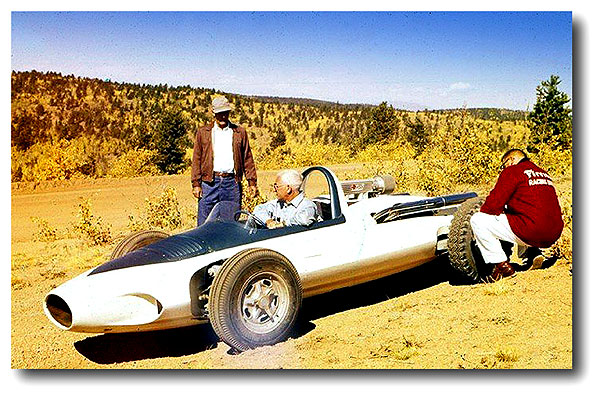 But there was a big, glairing problem with these European exotics – there’s just enough room for two passengers and “maybe” a copy of Vette Vues Magazine. In other words, you were not going to throw in two suitcases and go for a weekend get-away in your Countach, F40 Ferrari, or even your Fiero. The European sports car builders created the concept of the “Grand Touring Sports Car,” or “GT” car. “Grand Touring” meaning a big road trip for two, or an exotic, romantic get-away. (Oh’la la, Ba-BOOM!) A GT sports car starts with a stiff frame, responsive suspension, powerful brakes, more than adequate horsepower, and upscale interior amenities. Think of them as performance, personal, luxury, high-speed transportation machines. The key feature here being “usable space”.
But there was a big, glairing problem with these European exotics – there’s just enough room for two passengers and “maybe” a copy of Vette Vues Magazine. In other words, you were not going to throw in two suitcases and go for a weekend get-away in your Countach, F40 Ferrari, or even your Fiero. The European sports car builders created the concept of the “Grand Touring Sports Car,” or “GT” car. “Grand Touring” meaning a big road trip for two, or an exotic, romantic get-away. (Oh’la la, Ba-BOOM!) A GT sports car starts with a stiff frame, responsive suspension, powerful brakes, more than adequate horsepower, and upscale interior amenities. Think of them as performance, personal, luxury, high-speed transportation machines. The key feature here being “usable space”.
Starting with the1984 C4, the Corvette has been a constantly evolving GT sports car. By 1985 Chevrolet was touting that the Corvette was “The Fastest Car in America.” With a top speed of 150-mph, a tight suspension, huge grippy tires, and a good-size rear storage area, the Corvette was indeed a true “GT” sports car. And who doesn’t love performance AND functionality? Corvettes can be a beast if you want them to be, but I know people in the 60s and older that use their C6 Z06 for long trips. I asked Rollie Walriven (cover story for the December 2015 issue of Vette Vues) if his wife minded long trips in their C6 Z06? He said, “Oh, if she didn’t like it, there’d be no long trips in the Z06, that’s for sure!”
The main point is this: Corvettes have evolved to the point where they can run and perform with most anything on the road, and at the same time, the car can be a daily driver. Take a long weekend trip – no problem! Get some groceries – no problem. Toss in two sets of golf clubs, head out to the greens – no problem. You can’t do any of that with a McLaren 570S, Lamborghini Aventador, or even an El Cheepo Fiero. NOPE!
In September 2014 Don Sherman of Car and Driver Magazine reported, “We have serious dirt on GM’s secret mid-engine supercar.” C&D reported that the C8 “Zora ZR1” will cost around $150,000 and GM expects to make roughly 1,500 units.” First, C&D reported that the C8 would arrive as a 2017 model, so we’re now at least a year late. Also, we are to believe that the “Zora ZR1” will be a separate model that will be for sale next to the current version of the C7, until the C7 is phased out.” So, will the “Zora ZR1” be considered a C8 and the car that replaces the C7 be a C9? I can see the C9 feeding frenzy starting very soon.
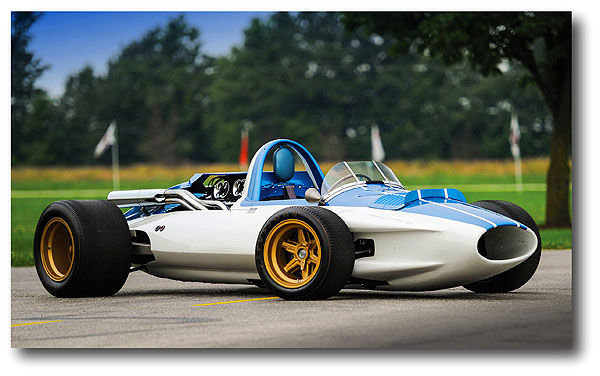 C8 Mid-Engine Corvette Conclusion: I’ll go out on a limb and say that no matter what you do to a mid-engine platform, it will never be a Grand Touring “GT” sports car, unless it comes with a matching travel trailer. While January 2018 sounds “out there,” it is only 18 months or so from now. In the mean time, we get to bench race, look back, and do our best to speculate forward. Chevrolet has been teasing and taunting the Corvette community with mid-engine Corvette concepts for 56 years! We will be highlighting the 14 major Corvette and Corvette-related, mid-engine concepts, starting with the 1960 CERV I and ending with the 1990 CERV III.
C8 Mid-Engine Corvette Conclusion: I’ll go out on a limb and say that no matter what you do to a mid-engine platform, it will never be a Grand Touring “GT” sports car, unless it comes with a matching travel trailer. While January 2018 sounds “out there,” it is only 18 months or so from now. In the mean time, we get to bench race, look back, and do our best to speculate forward. Chevrolet has been teasing and taunting the Corvette community with mid-engine Corvette concepts for 56 years! We will be highlighting the 14 major Corvette and Corvette-related, mid-engine concepts, starting with the 1960 CERV I and ending with the 1990 CERV III.
The First Mid-Engine “Corvette” the 1960 CERV I: Since Zora Arkus-Duntov was the performance guru and Godfather of the Corvette, and the CERV I was one of Zora’s pet R&D projects, the CERV I gets to be called, (abet loosely) a “Corvette.” Although it never wore a Corvette badge, it was indeed powered by various Corvette engines.
To understand this part of the Corvette story, you must read Jerry Burton’s 2002 book, “Zora Arkus-Duntov – The Legend Behind Corvette”. Zora often used GM and the resources of Chevrolet R&D as his racecar candy store. While Chevrolet’s strict adherence to the 1957 AMA Racing Ban precluded Duntov from actively engaging in Corvette racing activities, he managed to design and develop an impressive array of Corvette racing parts, unofficially knows as Duntov’s “Racer Kits.” Thanks to the lowly Corvair and its 4-speed manual transaxle, Zora saw a way to develop his concept of a mid-engine Corvette. This was the first of many of Zora’s mid-engine Corvettes and it must be pointed out that Duntov wasn’t the only engineer inside Chevrolet R&D that was working on the concept. We’ll get to engineer Frank Winchell later in the series.
At Riverside Raceway in 1960, Duntov unveiled one of the most unusual cars of his career at GM, the CERV I. (CERV – Chevrolet Engineering Research Vehicle) The car’s official reason for being was, “A research tool for Chevrolet’s continuous investigations into automotive ride and handling phenomena under more realistic conditions.” (wink, wink, RACING!) But everyone knew better. Duntov first got the idea of building a rear-engine racer in ‘57 while working out the details on the SS Corvette. Since R&D work was also going on with the Corvair and its unique transaxle, a mid-engine V-8 wasn’t outside of legitimate research. This alone may have been what got the project approved.
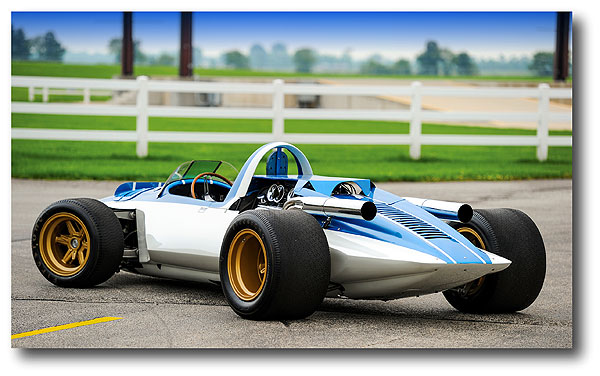 Duntov built the car to Indy dimensions, not to race at Indy, but to have some relevance to all-out racecars. Its too bad Zora never was able to run the car at Indy with an experienced Indy 500 driver. Wheelbase, length, and width were all at Indy specs. The car measured 172-inches in length, 52-inches in width, the wheelbase was 96-inches, and the front and rear track was 56-inches. The 283 V-8 was too big for Indy, but it was perfect for the Pikes Peak Hill Climb. So in September 1960, Duntov took the CERV I to Colorado for “testing” and although not officially timed, the car performed below the record for his class.
Duntov built the car to Indy dimensions, not to race at Indy, but to have some relevance to all-out racecars. Its too bad Zora never was able to run the car at Indy with an experienced Indy 500 driver. Wheelbase, length, and width were all at Indy specs. The car measured 172-inches in length, 52-inches in width, the wheelbase was 96-inches, and the front and rear track was 56-inches. The 283 V-8 was too big for Indy, but it was perfect for the Pikes Peak Hill Climb. So in September 1960, Duntov took the CERV I to Colorado for “testing” and although not officially timed, the car performed below the record for his class.
Most interesting was the CERV I’s all-aluminum small-block Chevy engine. Unlike the ‘69 big-block ZL-1, the engine used a high-silicon aluminum alloy for the block with no steel cylinder sleeves and forged aluminum Corvette pistons. (The 427 ZL-1 used pressed-in steel cylinder sleeves.) Bolt-on aluminum parts included heads, water pump, starter–motor body, clutch pressure plate, and flywheel. The intake manifold and clutch housing were cast in magnesium and the radiator was aluminum. The complete engine weighed 175-lbs less than its cast-iron stock version and made 353-horsepower at 6,200 rpm. Too bad the ’70-‘72 LT1 wasn’t all-aluminum.
Brakes were similar to what was offered in the RPO-684 heavy-duty brake and suspension option. The rear brakes were inboard-mounted, just outside the transaxle, and the front brakes were wheel-mounted. The rear suspension had upper and lower A-arms with coil springs and shocks. The front suspension also used steel-stamped A-arms with variable-rate coil springs over shocks. The front also has an 11/16-inch stabilizer bar and re-circulating ball-type steering with 12:1 ratio. The truss-like frame was made from 7/8-inch and 5/8-inch chrome-moly tubing, and weighed just 125-lbs. Larry Shinoda and Tony Lapine (later designer of the Porsche 924, 944, and 928) designed the lightweight fiberglass body.
Zora had WAY too much fun with this car. Over the years, various setups were tried; including; a twin-turbocharged with fuel-injection, a GMC Root-type supercharged, Hilborn injected, etc. A supercharged, injected version produced over 500-hp. Imagine that in a 1,800-lb car, including fuel, a driver, and skinny tires. On the scales, the CERV I had 58-percent of its weight on the rear wheels. Experiments with headers included Zoomy dragster-style, long equal-length headers, and large collector header setups.
Here’s another marker as to how advanced the 1960 CERV I was. A mid-engine racecar did not race at the Indy 500 until 1961 with Jack Brabham’s European grand prix-style “rear-engine” car. Although truly a mid-engine design, the new wave of Indy racecars were called “rear-engine” because the engines was behind the driver, as opposed to the then classic, Indy roadster layout. The first “rear-engine” car to win the Indy 500 was Jim Clark’s Team Lotus car in 1965. By 1969 all of the traditional Indy roadster-type racecars were gone. So, it looks like Mr. Duntov was ahead of the curve, or at the very least, tuned into the cutting-edge of then-contemporary racecar design.
The CERV I was very fast for its day. Duntov lapped Daytona at 167-mph and hit 172-mph on the Sebring strait. Finally, in ‘64, using a Hilborn injected 377 and a modified body, Zora drove the CERV-I to a lap speed of 206-mph at GM’s Milford test track. CERV I was a definite stretch for the Corvette R&D team. What it really did was keep racing in the lifeblood of Corvettes. There’s nothing quite like seeing a fast racecar, knowing that the hardware in that machine is very much like your daily driver. Racing builds brand loyalty. The CERV-I now resides in Mike Yeager’s “MY Garage Museum,” in Effingham, Illinois.
zzz
Coming up next in “The History of Mid-Engine Corvettes: 1960 to C8” we will be covering the 1962 Monza GT. For at least the first three decades of the Corvette, there were many inside Chevrolet that wanted the Corvette to be “something else.” Bigger, cheaper, smaller, lighter, and even one concept of a mid-engine layout powered by a flat-six Corvair engine! Like the four-seater 1963 Sting Ray concept, this one went nowhere. But it was cute and could be called, “the Father of the Mako Shark-II.” – Scott
We have 11×17 art prints of the 1960 CERV-I HERE.



